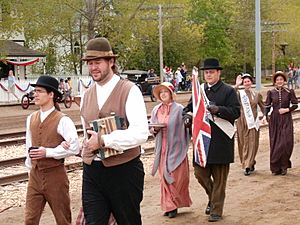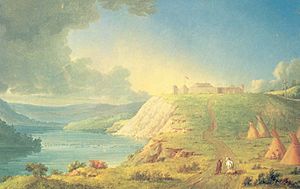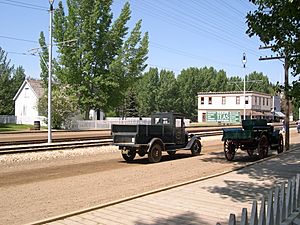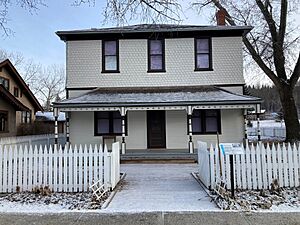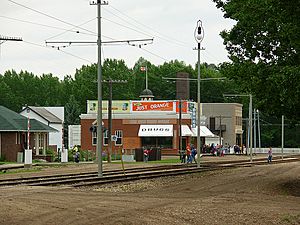Fort Edmonton Park facts for kids
 |
|
| Lua error in Module:Location_map at line 420: attempt to index field 'wikibase' (a nil value). | |
| Established | 1974 |
|---|---|
| Location | Edmonton, Alberta |
| Type | Living history |
| Owner | City of Edmonton |
| Public transit access | (to South Campus/Fort Edmonton Park station) |
Fort Edmonton Park is a super cool place to visit in Edmonton, Alberta, Canada! It's named after the very first European settlement in the Edmonton area. This park is the biggest living history museum in Canada.
It has both original buildings and amazing replicas that show you what life was like in Edmonton's past. This includes the history of Indigenous Peoples. During the summer, you'll meet friendly people dressed in old-fashioned clothes who act like they live in those times. They are called historical interpreters and they help bring history to life!
Contents
- Discovering Fort Edmonton Park's History
- Exploring the Park: A Journey Through Time
- Affiliations
- See also
Discovering Fort Edmonton Park's History
The idea for Fort Edmonton Park started way back in 1912. A group called the Women's Canadian Club wanted to save the original Fort Edmonton, which was still standing. Sadly, this idea didn't work out, and the old fort was torn down in 1915.
But people didn't give up! After World War II, there was new interest in creating a historical park. Construction for Fort Edmonton Park began in 1969. The plan was to show different parts of Edmonton's history.
The first part of the park, the fort, opened in 1974. Later, other areas were added. These include 1885 Street, 1905 Street, and 1920 Street. Since 1977, a real steam train has taken visitors from the park's entrance all the way to the fort. Each area has been a work in progress, with new things added over time.
Exploring the Park: A Journey Through Time
Fort Edmonton Park covers a huge area, about 158 acres! It's located along the south bank of the North Saskatchewan River. The park has five main sections, each showing a different time period.
You start your adventure at the Indigenous Peoples Experience. Then, you can visit a copy of the 1846 fort. After that, you move through time to 1885 Street, 1905 Street, and finally 1920 Street. You can hop on a working steam train at the park's entrance. It takes you to the fort, and from there, you walk through the different historical areas.
Besides the train, you can also ride horse-drawn carriages and old-fashioned streetcars. The train and streetcar rides are free with your admission ticket. However, there's a small fee for the horse-drawn carriages.
From May to September, you can chat with the costumed historical interpreters. They show you what life was like in their time period. You can also book tours with guides who aren't in costume throughout the year.
Indigenous Peoples Experience: Learning About First Nations and Métis Cultures
The Indigenous Peoples Experience is the newest part of the park. It opened in 2021 after a big renovation. This area helps you learn about the stories, lessons, cultures, and histories of local First Nations and Métis communities.
You can explore interactive exhibits, watch videos, and listen to music. The stories and ideas shared here come from over 50 local Indigenous historians, elders, and community members. In 2021, this museum won an award for its amazing exhibits. These exhibits were created with help from the Confederacy of Treaty 6 Nations and the Métis Nation of Alberta.
1846 Fort: The Fur Trade Era (1795–1859)
This section is a full-size copy of the original Hudson's Bay Company Fort Edmonton. It shows what life was like during the fur trade era. The replica fort was built using old diagrams and drawings from visitors like Paul Kane.
Just outside the fort's walls, you'll find a Cree camp. This shows the important role of First Nations people. Their trade of furs and supplies was vital for the fort to operate.
Cool Things to See at the Fort
- York Boat: You can see a copy of a York boat near the river. These boats were used to transport furs and goods. Sometimes, one is even in the water! You might also see another York boat being built inside the fort.
- The Rowand House: This huge house belonged to John Rowand and his family. It was one of the biggest houses in western Canada back then. It has four levels: one for servants, one for dining and business, one for the family, and a top floor for storage.
- The Men's Quarters: Across from the Rowand House, these apartments were where the Hudson's Bay Company workers lived. Some rooms were also workshops for skilled tradesmen. Many beds were needed because several men, and sometimes their families, lived in each small apartment.
- The Clerks' Quarters: This building was for the fort's educated clerks. The second floor, which would have been their bedrooms, wasn't built in this copy. So, this building is mostly a dining hall. This building, like others in the park, can be rented for private events.
- The Indian House/Trade Store: This was the main trading spot for furs brought by Indigenous people. They would trade furs for European goods. The fort workers would count, store, and then ship the furs to Hudson Bay to be sent to England.
- Aboriginal Camp: There's a small Cree camp just outside the fort. It shows how Indigenous people lived. The park hopes to add a larger Indigenous village in the future.
1885 Street: The Settlement Era (1871–1891)
While the fort was the first European settlement, people started moving out of the fort or coming from far away to farm in the late 1800s. 1885 Street shows the beginning of a town. You'll see early telegraph and printing press businesses. This area also reminds us of big political events like the North-West Rebellion of 1885.
What to Explore on 1885 Street
- Covered Wagon: See the type of wagon settlers used to travel overland from places like Winnipeg or Ontario. These wagons were made narrow to fit on the small trails.
- Jasper House Hotel: The original hotel is still in use downtown, but this is a copy of the first brick building in Edmonton. It can be rented for private events.
- McDougall Methodist Church: This is an original church that was moved to Fort Edmonton Park. Built in 1873, it was one of the first buildings outside Fort Edmonton. It shows how important Methodists were in early Edmonton.
- The North-West Mounted Police Outpost: This is a copy of the office used by the North-West Mounted Police. They were the first police force in the area, like the RCMP today.
- The Ottewell Homestead: This is a rebuilt house with an original barn from the same time. It shows how homesteaders lived when they settled in the Edmonton area in the late 1800s. You can even see live animals here!
1905 Street: The Municipal Era (1892–1914)
During this time, Edmonton officially became a city. In 1905, it was chosen as the capital of Alberta. This was a time of great economic growth for Edmonton. Because so many people were moving here, there wasn't enough housing, so a "tent city" appeared. You can see a copy of it on 1905 Street. Another important event was the opening of the University of Alberta in 1908, which is often mentioned here.
Highlights of 1905 Street
- Tent City: When Edmonton was booming, many new people arrived but couldn't find homes. Fort Edmonton Park's tent city shows the temporary solution people used. This actually happened again in 2007 when many people couldn't afford rising rents.
- Rutherford House:
This was the home of Alexander Cameron Rutherford, who was the first Premier of Alberta and the person who started the University of Alberta. It was moved to Fort Edmonton Park in 1968.
- Streetcar:
The Edmonton Radial Railway Society runs a streetcar that takes you between 1905 Street and 1920 Street. It's free to ride! You might also see old cars driving on this street and 1920 Street.
- Masonic Hall: This is a copy of a 1903 Masonic Hall. Upstairs, you'll find the Masonic Museum with old items and furniture. Downstairs, there are food services.
1920 Street: The Metropolitan Era (1914–1929)
This street shows Edmonton during and after World War I. While earlier eras had small businesses, Metropolitan Edmonton had bigger chain stores. Edmonton in this time also had modern technology, like airplanes!
What to See on 1920 Street
- Blatchford Field Air Hangar: This is a copy of the hangar from the old Edmonton City Centre Airport. It was Canada's first "air harbour." This building can also be rented for private events. A copy of a biplane, like the one flown by famous aviator Wop May, will be displayed here.
- Hotel Selkirk: This building looks like a hotel that used to be in downtown Edmonton. It actually works as a real hotel inside the park, so visitors can stay overnight!
- Mellon Farm: This building is an original! It was already on the land where Fort Edmonton Park is now because the Mellon family used to own this land.
- Al-Rashid Mosque: The Al-Rashid Mosque was the first mosque built specifically for prayer in Canada, and it's the oldest one still standing in North America. Even though it was built in 1938 (a bit after the 1920s era), moving it to Fort Edmonton Park saved it from being torn down. Many Muslim immigrants chose to live in Edmonton because there was a mosque here.
- 1920 Midway & Exhibition: A fun recreation of a 1920s midway opened in 2006. You can play different games and ride a carousel with hand-carved horses. The park later added an Exhibits Building and other rides like a Ferris wheel.
Affiliations
Fort Edmonton Park is connected with the CMA, the CHIN, and the Virtual Museum of Canada.
See also


